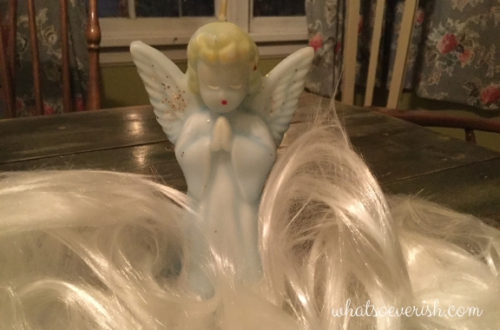
12 Easter Symbols
Every year our family learns about and remembers the symbols associated with Easter. When our children were younger we used 12 plastic Easter eggs and put a symbol and reading in each egg. Every night we opened an egg and read about the symbolism.
What you need:
12 plastic eggs
1 black marker
Printout of symbols, scriptures, and details
Symbols for each egg
Ways to use the eggs
- During Easter breakfast or dinner place one egg on each plate. Going in order have each person show the contents of the egg and read the scripture.
- Each day leading up the Easter open one egg, examine the symbol, read the scriptures and discuss.
- Hide the eggs around the house and have your children or grandchildren find them. Then read them in order discussing what each symbol represents.
- Place all the scriptures and symbols in a box or basket. Have your children match the scripture to the symbol then place in the eggs and display in a basket.
- Leave a carton of Easter Eggs on your neighbor’s porch so they can learn more about Easter.
- Place the symbols on a plate covered with a cloth. Take the cloth off and let your children glimpse the symbols. Have them write down everything they remember seeing. One-by-one show them each symbol and discuss it.
- Keep them in a basket and add one egg to your Easter Tree each day. (See XX)
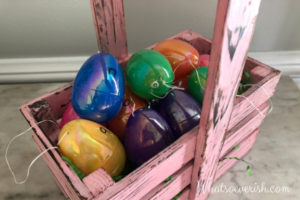
<pp?
(Sacrament Cup and/or Bread) – Jesus knew that the time had come for him to suffer for our sins and die. He gathered his Apostles around him for the Passover feast, which was to be his last supper with them. There he taught them about the Sacrament so that they would always remember him and what he was about to do for them…. he would bleed and suffer to take away the sins of all people upon the earth. (Matthew 26:17-30)
(Wash Towel) – After the sacrament, Jesus took a towel and poured water in a bowl. Jesus began to wash the Apostles feet. Peter asked Jesus, “Lord, dost thou wash my feet?” Jesus said, “For I have given you an example, that ye should [wash one another’s feet]…as I have done to you.” He wanted his Apostles to remember to serve as He was serving them. (John 13: 4-15)
(Three Dimes – Pieces of Silver) – With the light of a nearly full moon illuminating the way, Jesus and his apostles climbed the Mount of Olives to the Garden of Gethsemane. It was there, in the garden, that Jesus took upon himself not only our sins but also the pain, infirmities, and anguish of our world. It was not the physical pain that caused Him to suffer such torture as to bleed from every pore, but a spiritual agony of soul such as only a God was capable of experiencing. No other man, however great his powers of endurance, could have suffered so much. In that hour of anguish, Christ met and overcame all the horrors that Satan could inflict. (Matthew 26: 36-44)
A string of torch lights could be seen coming up the mount. It was a multitude of armed soldiers led by Judas Iscariot, one of Jesus’ Apostles who had been paid 30 pieces of silver to take them to Jesus. Approaching Jesus, Judas greeted Jesus and covered Him with kisses – which was the sign to the army that Jesus had been found. (Matthew 26:14-15)
(Rope) – It is Friday morning. After a long night of illegal trials, Jesus was sentenced to death. With a rope tied around His hands, He was beaten, laughed at and spit upon. An exhausted Jesus was delivered to Pontius Pilate, the governor. The angry mob kept yelling, “Crucify Him!!” Pilate really didn’t think that Jesus was guilty but the mob wanted Jesus dead. Pilate thought that if he scourged (whipped) Jesus and beat him until He was bleeding everywhere that the people would have pity on Him. So Pilate brought the bleeding wounded Jesus again before the crowd and said, “Behold the man!” But NO ONE would speak up for Jesus. (Matthew 27:1-2)
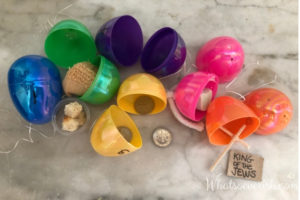
(Soap) – When Pilate saw that he could not stop the mob, he took water, and washed his hands before the multitude saying, “I am innocent of the blood of this just person.” And the people shouted, “His blood be on us.” (Matthew 27:24-26)
(King of the Jews) – The soldiers wove a crown of thorns and jammed it on the tired head of Jesus making His head bleed; they placed a purple robe on His shoulders and then, gloating and mocking him, they whipped Him and spit upon Him saying, “Hail, King of the Jews.” (Matthew 27:28-30)
The soldiers made Jesus carry a large, wooden cross to the place called Golgotha. Many times Jesus collapsed under the weight and mounting misery. The men along the road were silent; some women wept. The cross was raised between two thieves.
(Nail) – For capital punishment, the Romans chose the cruelest punishment of all…Crucifixion. It was a lingering death for its tortured victims. Jesus was stripped of his clothing. The soldiers nailed His hands and feet to the wooden cross and raised it so that Jesus’ body would hang there. He was left to die. While He hung, the skies began to darken. (Matthew 27: 50-54)
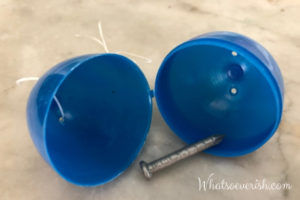
(Soldier) – As Jesus hung on the cross, the soldiers below Him cast lots for what was probably His only material possession, a coat. Jesus prayed in the soldiers’ behalf, “Father, forgive them; for they know not what they do.” As He hung in anguish, He only had loving words. To His mother, it was concern that she be cared for. To the thief who would repent, He gave hope. (Matthew 27:35-36)
At noon the heavens grew black for three hours as if the universe itself were weeping for the agony of the Creator. In that time all the infinite agonies and merciless pains of Gethsemane returned, and His Father’s spirit itself withdrew that the victory might be His. At the ninth hour, 3:00 pm, Jesus cried with a loud voice saying, “My God, my God, why hast thou forsaken me?”
In that eerie mid-afternoon darkness, someone ran and filled a sponge with vinegar. Having received the vinegar, Jesus said, “Father, it is finished. Thy will is done.” As He died, the veil of the temple was torn in half and the earth quaked and rocks were broke into pieces. Jesus’ mortal body had died.
A Roman soldier witnessing the events said, “Truly this was the Son of God.” (Matthew 27:50-54)
(White Linen Cloth) – Joseph, one of Jesus’ disciples, went to Pilate and begged him for the body of Jesus. Pilate commanded the body to be delivered to Joseph. Joseph wrapped Jesus’ body in a clean linen cloth and laid it in his own new tomb, which he had hewn out in the rock. This would be Jesus’ burial place. Jesus was buried in the tomb on Friday evening, for Saturday was the Sabbath and burying people on that day was not allowed. Some women wanted to put special ointments on Jesus’ body to prepare it for burial, but they didn’t have time, so they planned to come back as soon as the Sabbath was over to finish preparing His body.
(Rock) – A great stone was rolled in front of the tomb. Pilate ordered the chief Priests and Pharisees to make sure the stone was secure and ordered someone to watch and guard the tomb. (Matthew 27:60)
While it was yet dark on the morning of Sunday after the crucifixion, Mary Magdalene and other women arrived at the tomb of Jesus to mourn and anoint with spices the entombed body. To their utter surprise and sadness, the stone had been rolled away and Jesus’ body was not in the tomb. (Matthew 28:2-5)
(Bay Leaf and Spices) – While it was yet dark on the morning of Sunday after the crucifixion, Mary Magdalene and other women arrived at the tomb of Jesus to mourn and anoint with spices the entombed body. To their utter surprise and sadness, the stone had been rolled away and Jesus’ body was not in the tomb. (Matthew 28:2-5)
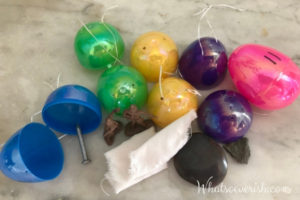
(Empty Egg) – As Mary Magdalene lingered by the tomb. Two angels appeared and said, “Why seek ye the living among the dead? Fear not ye; for we know that ye seek Jesus who was crucified. He is not here for He is risen!”
(I do not put this story in the egg. I want the children to know the tomb was empty.) Mary did not understand the words of the angels, for her sorrow at the loss of her beloved Lord was so strong. Mary turned herself away from the tomb and saw someone in the garden whom she did not recognize. He asked her, “Woman, why weepest thou? Whom seekest thou?”
Supposing Him to be the gardener, she boldly said, “Sir, if thou have borne him hence, tell me where thou hast laid him, and I will take him away.” Mary’s love for the Lord was so powerful that she offered to physically take the body by herself and see to his proper burial.
Now came one of the greatest moments in all of history, for this man was not the gardener….it was Jesus Christ with a resurrected body of flesh and bone. And He made Himself known by simply calling her by name in tones so familiar: “Mary”.
Now she saw, becoming the first witness of the risen Lord. Her tears of sorrow turned to joy as she exclaimed, “My beloved master!!”
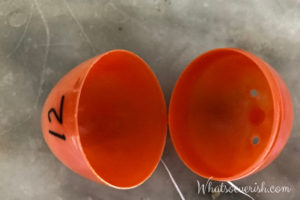
Print it Easter in 12 eggs
If you like this idea but want to make it on a grander scale: Easter Symbols in a Can and for more Christ-centered activities: Easter Week Activities



